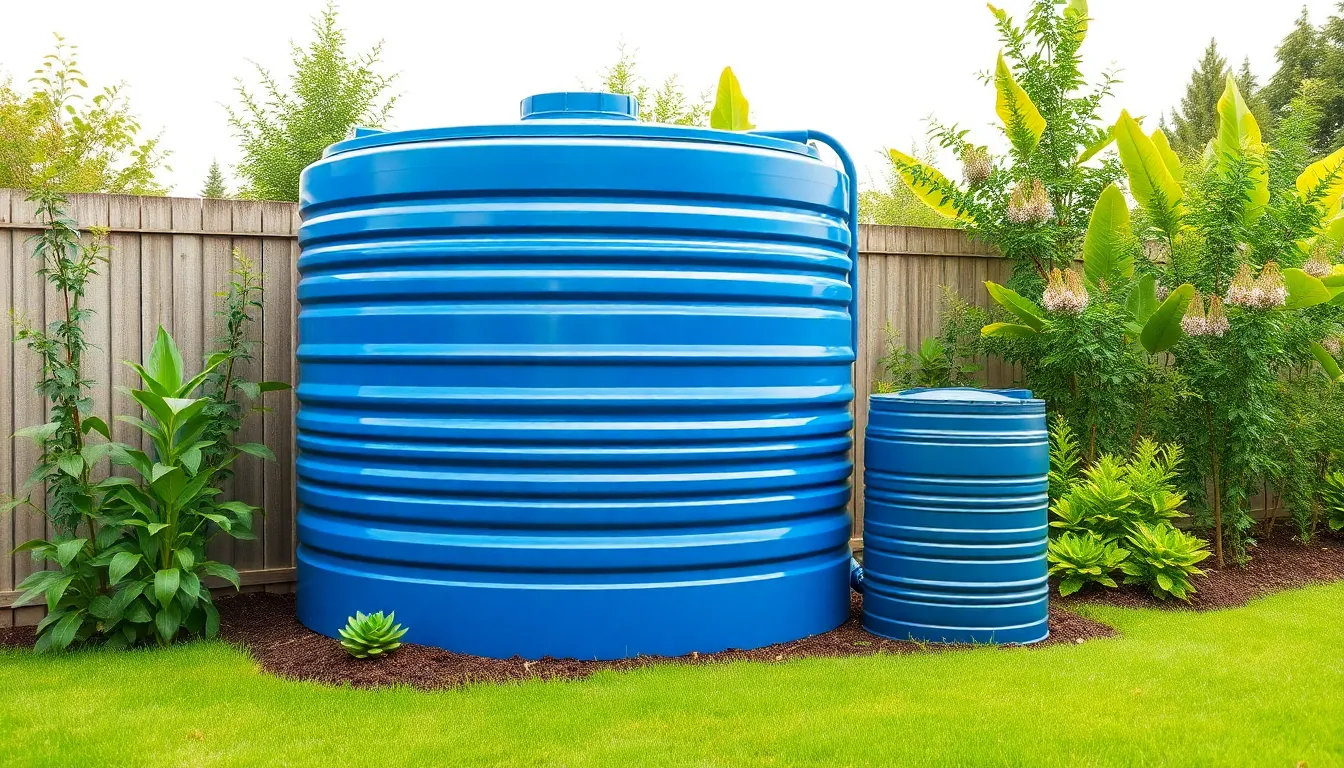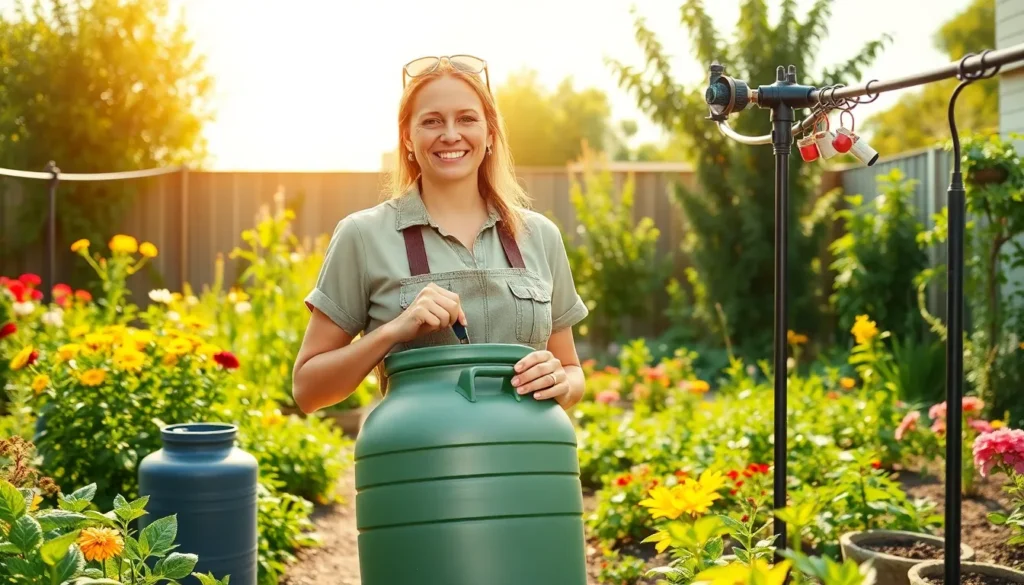Water is life, but without proper storage solutions, it can feel like trying to catch a fish with bare hands. Whether it’s for a backyard garden or emergency preparedness, having a reliable way to store water is crucial. Imagine the peace of mind knowing you’ve got enough H2O to keep your plants happy and your family hydrated, even during a drought.
From sleek rain barrels to high-tech tanks, the options for water storage are as diverse as a buffet line. No one wants to be the person scrambling for a cup when the world runs dry. So why not explore the clever and innovative solutions that can turn any home into a water-saving oasis? Dive in and discover how easy it is to keep your water woes at bay while adding a splash of sustainability to your life.
Table of Contents
ToggleOverview Of Water Storage Solutions
Water storage solutions play a crucial role in effective resource management. Rain barrels offer a simple way to capture rainwater from rooftops. Advanced water tanks provide larger capacities for extensive storage.
Cisterns serve as underground storage options, allowing for both above-ground and below-ground installations. The implementation of aquifer storage and recovery systems facilitates the recharging of groundwater reservoirs.
Drip irrigation systems improve water efficiency by minimizing waste through targeted application. Portable water storage bags ensure accessibility during emergencies or outdoor activities. Flexible bladders offer adaptable storage solutions in various settings, including gardens or farms.
Regulatory systems often dictate installation requirements and safety standards. With proper maintenance, these systems deliver long-term sustainability benefits. Investing in high-quality materials enhances durability, ensuring reliable usage over time.
Understanding local climate conditions can influence the choice of storage solutions. Areas with frequent rainfall might favor rain barrels, while drought-prone regions may require larger tanks.
Each solution has its unique benefits, catering to specific needs in both residential and agricultural contexts. Utilizing a combination of these options maximizes water efficiency. Exploring innovative technologies supports sustainable living practices while addressing water scarcity challenges.
Types Of Water Storage Solutions

Various water storage solutions exist to meet diverse needs and environments. Understanding these options helps in effective water management.
Above-Ground Storage
Above-ground storage options include tanks, rain barrels, and flexible bladders. Tanks, often made of polyethylene or fiberglass, hold significant amounts of water and are easily accessible. Rain barrels collect runoff from roofs and provide an economical solution for garden irrigation. Flexible bladders offer portability, making them ideal for emergency situations. Additionally, above-ground systems typically require less excavation, allowing for quicker installation and maintenance. Local regulations may affect how these units are placed, so checking compliance is essential.
Below-Ground Storage
Below-ground storage options consist of cisterns and aquifer storage systems. Cisterns collect rainwater or water from other sources and store it underground, promoting effective temperature control and reducing evaporation. Aquifer storage systems utilize naturally occurring groundwater, facilitating the recharge of local aquifers. These systems often require a comprehensive installation process, including excavation and reinforcement. Safety standards govern installation depth and materials used, ensuring structural integrity. When selecting below-ground solutions, considering local soil conditions and water tables remains crucial for performance.
Benefits Of Water Storage Solutions
Water storage solutions provide significant advantages in managing water resources effectively. These solutions enhance sustainability and offer peace of mind, particularly during dry spells.
Conservation Of Water
Conservation of water emerges as a primary benefit of these storage solutions. Rain barrels, for example, capture runoff, effectively reducing waste. Utilizing rainwater not only curbs dependency on municipal supplies but also promotes eco-friendly practices. Moreover, the use of cisterns can significantly lower groundwater extraction. Implementing drip irrigation systems further maximizes water usage by delivering moisture directly to plant roots. In drought-prone areas, these solutions prove invaluable in preventing water loss. Each method contributes to an overall reduction in consumption, promoting responsible water management.
Emergency Preparedness
Emergency preparedness becomes vital when considering water storage solutions. Accessible water storage options, such as portable tanks, ensure readiness during unforeseen circumstances. Reliable water sources provide essential support in emergencies, making it easier to maintain hygiene and hydration. Cisterns can serve as significant reserves, supplying water during outages or natural disasters. Promoting community resilience, these systems encourage self-sufficiency. Residents can proactively prepare by installing appropriate solutions tailored to their environment. Planning for emergencies equips households with confidence in their ability to address sudden water shortages.
Factors To Consider When Selecting Solutions
Selecting the right water storage solution requires careful evaluation. Several key factors influence this decision, including size and capacity as well as material and durability.
Size And Capacity
Choosing the right size and capacity ensures that the storage solution meets specific needs. Assessing household water requirements helps determine the appropriate volume. For example, a family may need at least 50 gallons for daily use, while a community may require several thousand gallons. Multipurpose use, such as gardening and emergencies, necessitates larger tanks. Considering available space also plays a critical role in selecting the optimal size for installation. Overestimating capacity can lead to wasted resources, so precise calculations are essential.
Material And Durability
Material and durability significantly impact the longevity of water storage solutions. Common materials include plastic, fiberglass, and concrete, each with unique advantages. Plastic tanks offer portability and resistance to corrosion, while fiberglass provides strength and lightweight options. Concrete cisterns ensure long-lasting durability but require more effort for installation. Choosing UV-resistant materials enhances performance against environmental elements, thereby prolonging functional life. Regular inspections also promote durability, ensuring small issues do not escalate into larger repairs.
Investing in effective water storage solutions is crucial for sustainability and emergency readiness. By selecting the right system—whether above-ground or below-ground—individuals can significantly enhance their water conservation efforts. Understanding local climate conditions and household needs ensures that the chosen solution meets specific requirements.
Regular maintenance and adherence to safety standards are essential for long-term functionality. With the right approach, water storage not only provides peace of mind during droughts but also fosters community resilience. Embracing these innovative technologies empowers everyone to manage their water resources wisely.



